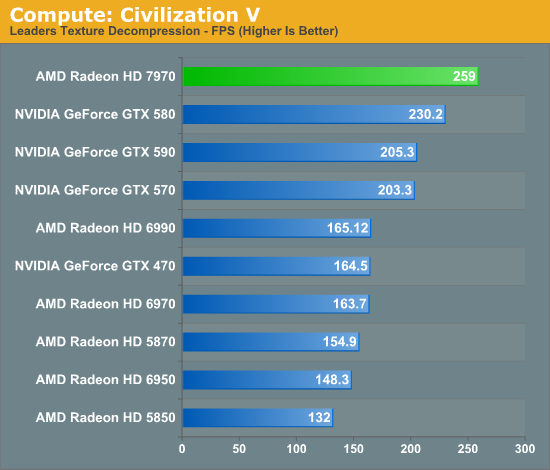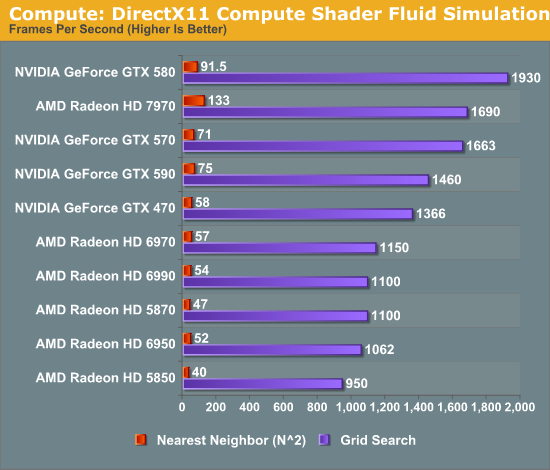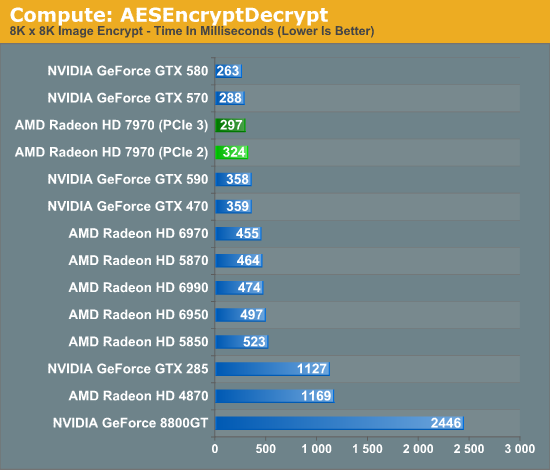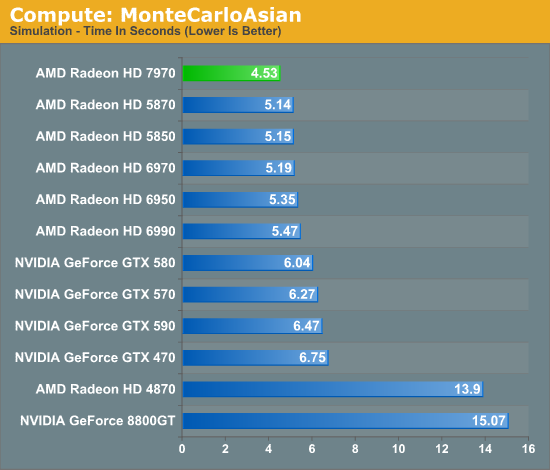AMD Radeon HD 7970 Review: 28nm And Graphics Core Next, Together As One
by Ryan Smith on December 22, 2011 12:00 AM EST- Posted in
- GPUs
- AMD
- Radeon
- ATI
- Radeon HD 7000
Compute: The Real Reason for GCN
Moving on from our game tests we’ve now reached the compute benchmark segment of our review. While the gaming performance of the 7970 will have the most immediate ramifications for AMD and the product, it is the compute performance that I believe is the more important metric in the long run. GCN is both a gaming and a compute architecture, and while its gaming pedigree is well defined its real-world compute capabilities still need to be exposed.
With that said, we’re going to open up this section with a rather straightforward statement: the current selection of compute applications for AMD GPUs is extremely poor. This is especially true for anything that would be suitable as a benchmark. Perhaps this is because developers ignored Evergreen and Northern Islands due to their low compute performance, or perhaps this is because developers still haven’t warmed up to OpenCL, but here at the tail end of 2011 there just aren’t very many applications that can make meaningful use of the pure compute capabilities of AMD’s GPUs.
Aggravating this some is that of the applications that can use AMD’s compute capabilities, some of the most popular ones among them have been hand-tuned for AMD’s previous architectures to the point that they simply will not run on Tahiti right now. Folding@Home, FLACC, and a few other candidates we looked into for use as compute benchmarks all fall under this umbrella, and as a result we only have a limited toolset to work with for proving the compute performance of GCN.
So with that out of the way, let’s get started.
Since we just ended with Civilization V as a gaming benchmark, let’s start with Civilization V as a compute benchmark. We’ve seen Civilization V’s performance skyrocket on 7970 and we’ve theorized that it’s due to improvements in compute shader performance, and now we have a chance to prove it.

And there’s our proof. Compared to the 6970, the 7970’s performance on this benchmark has jumped up by 58%, and even the previously leading GTX 580 is now beneath the 7970 by 12%. GCN’s compute ambitions are clearly paying off, and in the case of Civilization V it’s even enough to dethrone NVIDIA entirely. If you’re AMD there’s not much more you can ask for.
Our next benchmark is SmallLuxGPU, the GPU ray tracing branch of the open source LuxRender renderer. We’re now using a development build from the version 2.0 branch, and we’ve moved on to a more complex scene that hopefully will provide a greater challenge to our GPUs.

Again the 7970 does incredibly well here compared to AMD’s past architectures. AMD already did rather well here even with the limited compute performance of their VLIW4 architecture, and with GCN AMD once again puts their old architectures to shame, and puts NVIDIA to shame too in the process. Among single-GPU cards the GTX 580 is the closest competitor and even then the 7970 leads it by 72%. The story is much the same for the 7970 versus the 6970, where the 7970 leads by 74%. If AMD can continue to deliver on performance gains like these, the GCN is going to be a formidable force in the HPC market when it eventually makes its way there.
For our next benchmark we’re once again looking at compute shader performance, this time through the Fluid simulation sample in the DirectX SDK. This program simulates the motion and interactions of a 16k particle fluid using a compute shader, with a choice of several different algorithms. In this case we’re using two of them: a highly optimized grid search that Microsoft based on an earlier CUDA implementation, and an (O)n^2 nearest neighbor method that is optimized by using shared memory to cache data.

There are many things we can gather from this data, but let’s address the most important conclusions first. Regardless of the algorithm used, AMD’s VLIW4 and VLIW5 architectures had relatively poor performance in this simulation; NVIDIA meanwhile has strong performance with the grid search algorithm, but more limited performance with the shared memory algorithm. 7970 consequently manages to blow away the 6970 in all cases, and while it can’t beat the GTX 580 at the grid search algorithm it is 45% faster than the GTX 580 with the shared memory algorithm.
With GCN AMD put a lot of effort into compute performance, not only with respect to their shader/compute hardware, but with the caches and shared memory to feed that hardware. I don’t believe we have enough data to say anything definitive about how Tahiti/GCN’s cache compares to Fermi’s cache, this benchmark does raise the possibility that GCN cache design is better suited for less than optimal brute force algorithms. In which case what this means for AMD could be huge, as it could open up new HPC market opportunities for them that NVIDIA could never access, and certainly it could help AMD steal market share from NVIDIA.
Moving on to our final two benchmarks, we’ve gone spelunking through AMD’s OpenCL archive to dig up a couple more compute scenarios to use to evaluate GCN. The first of these is AESEncryptDecrypt, an OpenCL AES encryption routine that AES encrypts/decrypts an 8K x 8K pixel square image file. The results of this benchmark are the average time to encrypt the image over a number of iterations of the AES cypher.

We went into the AMD OpenCL sample archives knowing that the projects in it were likely already well suited for AMD’s previous architectures, and there is definitely a degree of that in our results. The 6970 already performs decently in this benchmark and ultimately the GTX 580 is the top competitor. However the 7970 still manages to improve on the 6970 by a sizable degree, and accomplishes this encryption task in only 65% the time. Meanwhile compared to the GTX 580 it trails by roughly 12%, which shows that if nothing else Fermi and GCN are going to have their own architectural strengths and weaknesses, although there’s obviously some room for improvement.
One interesting fact we gathered from this compute benchmark is that it benefitted from the increase in bandwidth offered by PCI Express 3.0. With PCIe 3.0 the 7970 improves by about 10%, showcasing just how important transport bandwidth is for some compute tasks. Ultimately we’ll reach a point where even games will be able to take full advantage of PCIe 3.0, but for right now it’s the compute uses that will benefit the most.
Our final benchmark also comes from the AMD OpenCL archives, and it’s a variant of the Monte Carlo method implemented in OpenCL. Here we’re timing how long it takes to execute a 400 step simulation.

For our final benchmark the 7970 once again takes the lead. The rest of the Radeon pack is close behind so GCN isn’t providing an immense benefit here, but AMD still improves upon the 6970 by 14%. Meanwhile the lead over the GTX 580 is larger at 33%.
Ultimately from these benchmarks it’s clear that AMD is capable of delivering on at least some of the theoretical potential for compute performance that GCN brings to the table. Not unlike gaming performance this is often going to depend on the task at hand, but the performance here proves that in the right scenario Tahiti is a very capable compute GPU. Will it be enough to make a run at NVIDIA’s domination with Tesla? At this point it’s too early to tell, but the potential is there, which is much more than we could say about VLIW4.










292 Comments
View All Comments
RussianSensation - Saturday, January 14, 2012 - link
BF3 is not a 2012 game.......Also, most of us have been gaming on our older cards. Who in the world who has a previous high-end card is going to drop $600 for BF3 alone? No thanks.
SSIV - Saturday, February 18, 2012 - link
Since there's a new driver out for there cards we can now regard these results with a grain of salt. Revise the benchmarks!DaOGGuru - Thursday, March 1, 2012 - link
I don't know why people keep forgeting about the 560ti 2win. Yes I said 2win = 2 560ti processors on one card. It still kills the 7970 numbers in BF3 by 20Fps. and is same price. It also beats the 580 and is cheaper. It's a single card with 50amp min. draw and it will smoke anything except 590 and the 6990...http://www.guru3d.com/article/evga-geforce-gtx-560...
CeriseCogburn - Thursday, March 8, 2012 - link
Oh, right, well this isn't an nvidia card review, so we won't hear from 50 posts about how some CF (would be SLI of course in this case) combo will whip the crap out of it in performance and price...You know ?
That's how it goes...
Usually the articel itself rages on about how some amd CF combo is really so much good and better and blah blah blah.... then the rpice perf, then the results - on and on and on ....
---
The angry ankle biters are swarmed up on the under red dog radeon side...
--
So you made a very good point, I'm just sorry it took 29 pages of reading to get to it, in it's glorious singularity.... you shouldn't strike out in independent thought like that it's dangerous.... not allowed unless the card being reviewed is an nvidia !!!!
DaOGGuru - Thursday, March 1, 2012 - link
oops... forgot to say look at previous post links BF3 rating for the 560ti 2win and compare to this charts 7970 fps. The 2win is pumping out @20 more FPS and is $50.00 - $100.00 cheaper than the 7970... lame.. ATi is still behind Nvidia but proud of it! lol They are just now catching up to Nvidia's tessellations and oh and AFTER they changed to a "cuda core copy" architecture and posting it as big news... Evga's older 560ti 2win still dusts it by 20FPS.. lame.DaOGGuru - Thursday, March 1, 2012 - link
sorry 10FPS not 20.. it's late.DaOGGuru - Thursday, March 1, 2012 - link
I don't get what's the hub-bub about the 7970.. sure it's the fastest single cpu;BUT, for $50.00-$100.00 less you can get the 560Ti 2win (dual cpu) that smokes the 7970 and the 2win PCB does have an SLI bridge and is cabapable of doing SLI to a second card but it's currently locked by Nvidia (see paragraph 3).Also, the 2win draws a min of only 50amps (way less than most sli configurations) 1. has a considerably lower noise dba, 2. runs cooler and with less power than almost all the high end cards and 3. will run 3 montiors in Nvidia 2D and 3D surround off a single card! 4.Will kill the GTX 580 by @33-23% (depending on review) 5. Will beat the 590 in some sample testing for TDP. And finally 6. will kill the 7970 by 10-20FPS in BF3 including by 10FPS in 1920x1200 4AA-16AF Ultra high mode. So, why have people forgotten the 2win? It's a singlecard, multi-GPU, full 3D/2D surround without a second card in SLI, $500.00USD beast !
OH and for those that say you can't SLI with a second 2win.... http://www.guru3d.com/article/evga-geforce-gtx-560... (this review states on conclusion page) > quote " you will have noticed there is a SLI connector on the PCB. Unfortunately you can not add a second card to go for quad-SLI mode. It's not a hardware limitation, yet a limitation set by NVIDIA, the GTX 560 Ti series is only allowed in 2-way SLI mode, which this card already is."
... So actually, the card is cabale 2card SLI but Nvidia for some (gosh aweful reason) won't let the dog off the chain. Probably because it will absolutely kill the need for a GTX580, 570, 560 Ti SLI configuration for ever!
Resources: (pay attention to BF3 FPS and compare to 7970 FPS in this article.)
http://www.anandtech.com/show/5048/evgas-geforce-g...
http://www.guru3d.com/article/evga-geforce-gtx-560...
Peace...
DaOGGuru - Thursday, March 1, 2012 - link
I don't get what's the hub-bub about the 7970.. sure it's the fastest single CPU; BUT, for $50.00-$100.00 less you can get the 560Ti 2win (dualCPU) that smokes the 7970 and the 2win PCB does have an SLI bridge and is capable of doing SLI to a second card but it's currently locked by Nvidia (see paragraph 3).Also, the 2win draws a min of only 50amps (way less than most sli configurations) 1. Has a considerably lower noise DBA, 2. runs cooler and with less power than almost all the high end cards and 3. Will run 3 monitors in Nvidia 2D and 3D surround off a single card! 4.Will kill the GTX 580 by @33-23% (depending on review) 5. Will beat the 590 in some sample testing for TDP. And finally 6. will kill the 7970 by 10-20FPS in BF3 including by 10FPS in 1920x1200 4AA-16AF Ultra high mode. So, why have people forgotten the 2win? It's a single card, multi-GPU, full 3D/2D surround without a second card in SLI, $500.00USD beast !
OH and for those that say you can't SLI with a second 2win.... http://www.guru3d.com/article/evga-geforce-gtx-560... (this review states on conclusion page) > quote " you will have noticed there is a SLI connector on the PCB. Unfortunately you cannot add a second card to go for quad-SLI mode. It's not a hardware limitation, yet a limitation set by NVIDIA, the GTX 560 Ti series is only allowed in 2-way SLI mode, which this card already is."
... So actually, the card is capable 2card SLI but Nvidia for some (gosh awful reason) won't let the dog off the chain. Probably because it will absolutely kill the need for a GTX580, 570, 560 Ti SLI configuration forever!
Resources: (pay attention to BF3 FPS and compare to 7970 FPS in this article.)
http://www.anandtech.com/show/5048/evgas-geforce-g...
http://www.guru3d.com/article/evga-geforce-gtx-560...
Peace...
CeriseCogburn - Thursday, March 8, 2012 - link
Ummm.... I read you, I see your frustration with all the posts - just refer to my one above there - you really should not be dissing the new amd like that - they like are 1st and uhh... nvidia is evil... so no comparisons like that are allowed when the fanboy side content is like 100 to 1....Now next nvidia card review you will notice a hundred posts on how this or that CF beats the nvidia in price perf and overall perf, etc, and it will be memorized and screamed far and wide...
Just like... your point "doesn't count", okay ?
It's best to ignore you GREEN fanboy types... ( yes even if you point out gigantic savings, or rather especially when you do...)
Thanks for waiting till page 30 - a wise choice.
CeriseCogburn - Sunday, March 11, 2012 - link
Southern Islands is a whole generation late. AMD promised us this SI in the last generation 6000 series. Then right before that prior release, they told us they had changed everything and 6000 was not Southern Islands anymore. LOLTalk about late - it's what two years late ?
Maybe it's three years....
In every case here, Nvidia beat them to the core architecture by two years. Now amd is merely late to the party crashing copycats....
That's late son, that's not original, that's not innovative, that's not superior, it's tag a long tu loo little sister style.